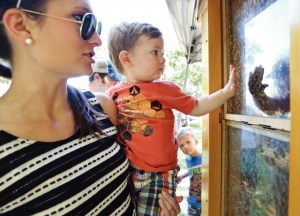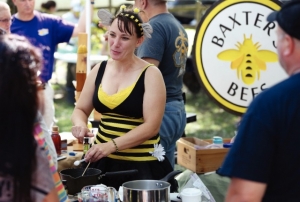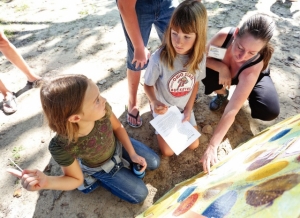Community gathers to learn buzz-skill
By John Joyce
Published in News on August 23, 2015 1:50 AM

News-Argus/CASEY MOZINGO
Jackson Baur, 2, reaches out to touch the clear beehive set up by the Wayne County Beekeepers Association at Waynesbourough Park for the annual Honeybee Day. Afraid at first, Jackson was encouraged by his mother, Melissa, to explore his curiosity.

News-Argus/CASEY MOZINGO
Dressed as a bee, Shannon Baxter gives a beeswax lip balm demonstration at the Baxter's Bees booth at Waynesborough Park Saturday. In addition to selling goods made from honey and wax, many of the vendors used the time to educate the public about bees.

News-Argus/CASEY MOZINGO
From left, Elissa Rasmussen, 8, and Katie Immel, 9, get help from Chastity Cerny with the Honeybee Day scavenger hunt.
Last spring, Allen Johnson noticed a slight change in the taste of the honey his beehives were producing.
There was something new -- and also familiar -- he could not quite place.
"Strawberry," Johnson said. Worker bees from his eight honeybee hives were bringing back nectar and pollen from nearby strawberry fields and depositing them in the honeycombs.
"Depending on what they get, what kind of nectar they get and what the bring in from the different flowers, that's what gives the honey its different kinds of taste," Johnson said.
He and the Beekeepers of the Neuse were out in Waynesboro Park Saturday morning welcoming families and fellow fans of bees who stopped by to learn about beekeeping and honey production.
Club president Summer Williamson said the Beekeepers of the Neuse is more than 100 members strong and is actively recruiting. The group meets every third Thursday of each month and classes for new beekeepers are held Saturdays at the Wayne Center. But bees are good for more than simply producing table honey, she said.
"One in every three bites of food you eat is because of honeybees," Mrs. Williamson said. "And if it weren't for honeybees, there would be no almonds," she added. Placards printed with facts such as these dotted the park Saturday.
Park visitors learned that bees can fly up to 15 miles per hour; that a bee would need to collect nectar from 2 million flowers to make a pound of honey; and that honey is both antibacterial and antifungal.
Children soaked up as much knowledge as they could from each booth, buzzing around the park on a honeybee scavenger hunt.
Beekeeper Katie Duff administered the hunt. After she and her husband moved from Raleigh to Goldsboro about a year ago, Mrs. Duff began beekeeping as a hobby and a way of meeting new people.
"There is a lot to be learned and the club meetings are a great place to come and get questions answered," she said. The club is a community within a community where people of all backgrounds can come together around a common interest.
"It is a science but an art," Mrs. Duff said.
The science behind beekeeping begins with biology -- how the bees interact and what drives them to produce the honey that they, and the public, consume each day.
That process was made visible with a cross section of a hive manned by Johnson in the middle of the park
It all starts with the queen, he explained.
"She is the boss of this hive. Her pheromones tell everybody else what to do," he said.
Queens mate once in their lifetime and then lay thousands of eggs a day for the rest of their life, generating a colony that, at its summer peak, can number 80 to 50,000 bees.
But what to do with all the honey? One doesn't have to be a scientist to figure out there are more uses for honey than spooning it into a tea cup when battling the flu.
But having a background in biology and chemistry doesn't hurt either, Shannon Baxter said.
She and her husband, Steve, blend honey and beeswax with essential oils to make soaps, balms, ointments and body lotions, which they sell. The couple from Zebulon owns Baxter's Bees, a beekeeping business that boasts 60 hives of its own.
"I use the products of the hive -- the pollen, the propylate, the beeswax and honey -- to create handcrafted products, skin care items and other all natural products," Mrs. Baxter said.
She said she got into beekeeping five years ago after adopting a dog from the Nash County Animal Shelter.
"She had a horrible, horrible skin rash," she said. The shepherd-chow-collie mix was constantly itching.
"Her skin was in such bad condition. I tried everything from the store that said, 'chamomile, lavender, soothing, healing ...,' and none of it worked," Mrs. Baxter explained.
The couple had already begun developing soaps and lotions, so Steve said to his wife, ironically, "You know, honey, you do make soaps," she recounted.
She did some research, created a soap containing honey and washed her dog with it.
"The first time I washed her, the entire rash went away," she said.
